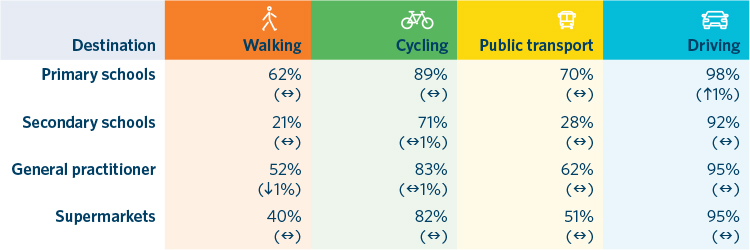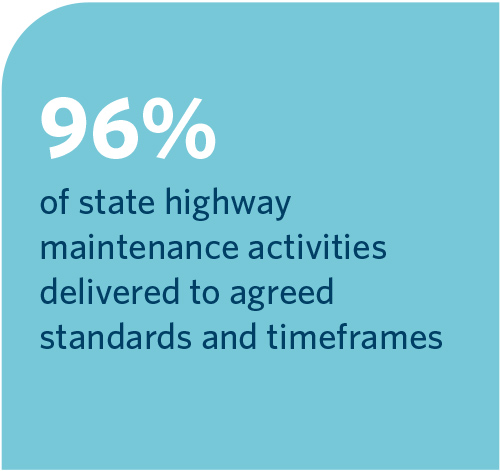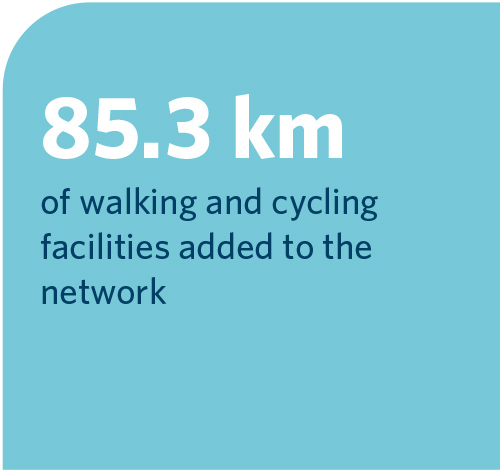As stewards of the state highway network, we are responsible for ensuring our roads fulfil their important function in moving people and goods to support the economy, as well as providing access for people to get to places of study and work and to connect with family and friends.
We must plan for a modern transport system with a mix of reliable transport options that keep people and products safely moving. We’re working to ensure transport choices are being supported by a growing network of cycleways, improved public transport, better pedestrian connections and street environments that create a sense of community and connection.

Access to social opportunities by mode – proportion of population within 15-minute access to the nearest school, health facility and supermarket during morning peak
We worked with our local partners to develop mode shift plans in Christchurch, Hamilton, Queenstown, Tauranga and Wellington. Mode shift is about growing the share of travel by public transport, walking and cycling. We continue working with Kāinga Ora and councils to improve integrated transport and spatial planning.
Making our streets safer for people to bike, scoot or walk is also what the Innovating Streets for People programme is looking to improve. This year we approved funding for 74 projects planned across 30 councils, with 65 projects delivered in 2020/21. Many communities are already experiencing the benefits of simple street changes that encourage people to confidently walk or bike due to reduced vehicle speeds.

Mode share – proportion of trips by mode (results from the Household Travel Survey)
Access to frequent public transport services at peak times in the metropolitan centres has improved. Compared to last year about 100,000 more people had access to these services in 2020/21. We’ve also seen positive movement in the number of people being able to access key social and economic opportunities by public transport and active modes.
Despite the disruption caused by COVID-19 and more people working from home, the three-year rolling average results from the Household Travel Survey indicate the share of travel modes remain relatively unchanged from previous years. The proportion of people using public transport and active modes has marginally increased year-on-year, even though the frequency of travel has reduced since pre-COVID norms.
Rail contributes many benefits, including reduced road network congestion and transport emissions, and improved safety and resilience across the land transport system. We provided advice to the Minister of Transport on KiwiRail’s Rail Network Investment Programme and now have systems in place to fund programme activities through the National Land Transport Fund.
The Waka Kotahi Freight Action Plan was also completed in June 2021. This work will help lay the foundations for moving freight off roads, which is crucial to improving safety and reducing emissions from the transport sector as a whole.
We’ve been effective in our operational responses to keep things moving after significant disruptions. We acted quickly on extreme weather events and the incident that caused structural damage to the Auckland Harbour Bridge. We worked closely with our stakeholders, partners and communities to manage these responses successfully. Our target for resolving road closures within standard timeframes was not achieved due to weather-related closures on long stretches of the state highway during winter and other weather events. Most notably in July 2020 a Northland storm triggered several road closures caused by landslides and flooding, and in May 2021 torrential rain in South Canterbury caused river overflows and floods leading to road closures.
We achieved all milestones for Te Ahu a Turanga, the Manawatū–Tararua highway this year, with the project ahead of its earthworks programme. There is strong community, council and iwi support for the project, which also won a national planning award. Physical completion of all Kaikōura earthquake recovery projects was achieved in June 2021. Nearly 9,000 people from 350 organisations from across Aotearoa and around the world helped to restore the transport corridor along the Kaikōura coastline and then build it back stronger and more resilient.
Waka Kotahi is delivering projects for the New Zealand Upgrade Programme (NZUP) that support greater transport choice with balanced investments in public transport, roads, and walking and cycling. This year we achieved year-end milestones for 10 out of 19 NZUP significant capital projects with progress made on several others.
In June 2021 the government confirmed the direction and funding commitment to deliver NZUP. This certainty means we can now fully deliver significant projects to help future proof the economy, get our cities moving, and make our roads safer.




